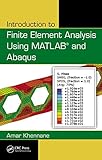Introduction to finite element analysis using MATLAB and Abaqus / Amar Khennane.
By: Khennane, Amar [author.] .
.
Material type:  BookPublisher: Boca Raton : Taylor & Francis, 2013Description: 1 online resource (xxix, 457 pages).ISBN: 9780429166433.Subject(s): MATLAB
BookPublisher: Boca Raton : Taylor & Francis, 2013Description: 1 online resource (xxix, 457 pages).ISBN: 9780429166433.Subject(s): MATLABch. 1. Introduction -- ch. 2. Bar element -- ch. 3. Beam element -- ch. 4. Rigid jointed frames -- ch. 5. Stress and strain analysis -- ch. 6. Weighted residual methods -- ch. 7. Finite element approximation -- ch. 8. Numerical integration -- ch. 9. Plane problems -- ch. 10. Axisymmetric problems -- ch. 11. Thin and thick plates.
This book introduces the theory of the finite element method using a balanced approach between its mathematical formulations and programming implementation. The computer implementation is carried out using MATLAB, while the practical applications are carried out in both MATLAB and Abaqus. All of the key steps are presented in great detail. MATLAB will allow the reader to focus on the finite element method by alleviating the programming burden. Detailed step-by-step procedures for solving sample problems with Abaqus interactive and keyword editions are provided at the end of each chapter-- Provided by publisher.


There are no comments for this item.